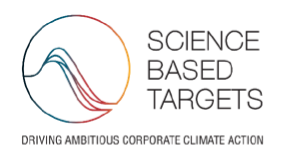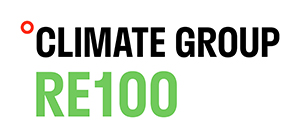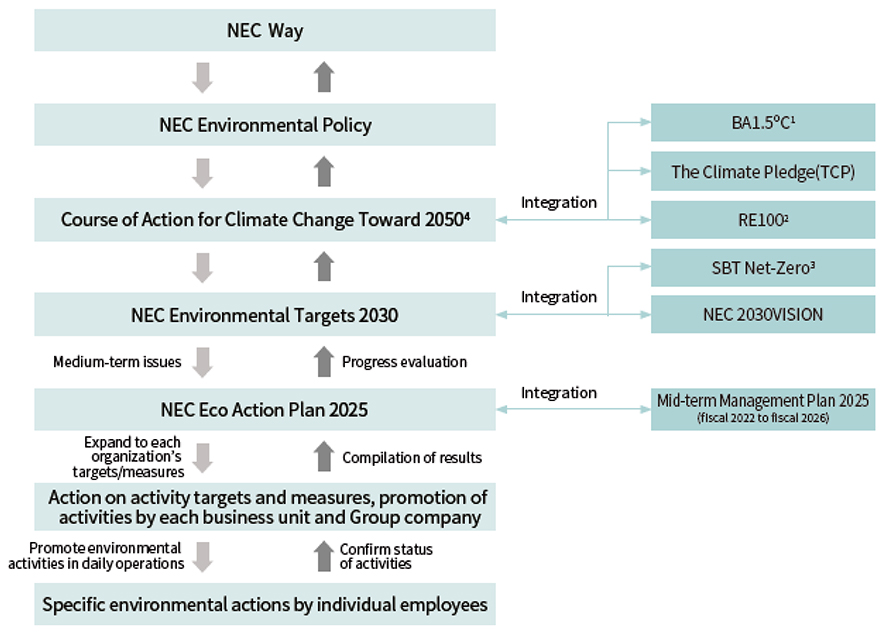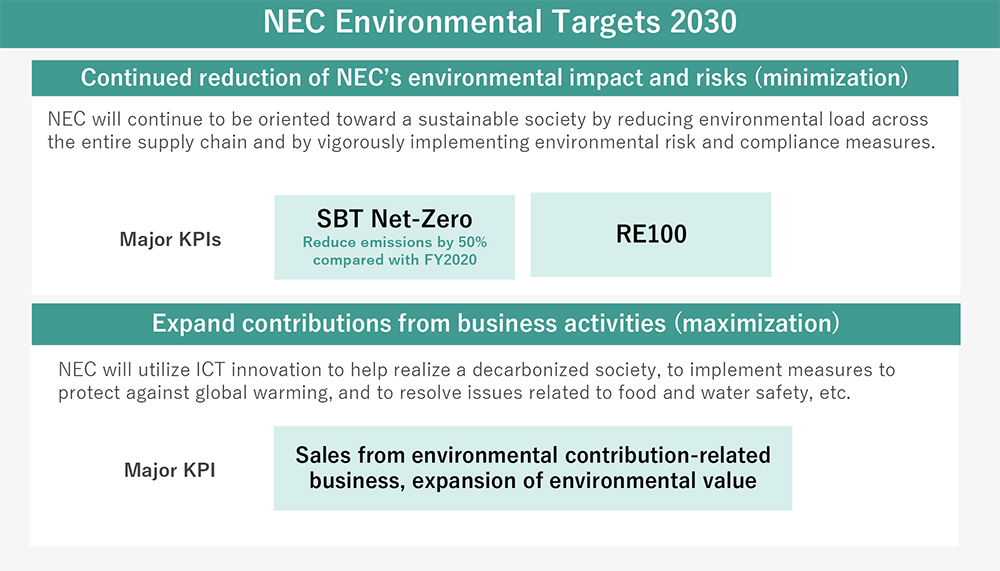Global Site
Displaying present location in the site.
Targets and Achievement
Medium- to Long-term Targets
Position of Environmental Management
At NEC, we have set medium- and long-term environmental targets based on the NEC Way that align with trends both inside and outside the Company. With the aim of being carbon neutral by 2040, we are currently defining specific activities for the NEC Eco Action Plan 2025, a five-year plan from fiscal 2022 through fiscal 2026, and are encouraging all of our employees to take action.
- *1Business Ambition for 1.5°C
- *2An international initiative in which companies aim to use 100% renewable energy to produce the electricity used in their businesses
- *3Science Based Targets. Greenhouse gas (GHG) emission reduction targets that align with levels outlined in the Paris Agreement. We obtained SBT Net-Zero certification in April 2024. Details about the certified targets are available here.
- *4We have moved our carbon neutral target up to 2040 because we have joined The Climate Pledge. Accordingly, the contents of the Course of Action for Climate Change have been reinterpreted as the Action Guidelines on Climate Change toward 2040.
Targets
Net Zero Emissions by 2040
NEC joined The Climate Pledge in September 2022, moving up its goal of achieving carbon neutrality from 2050 to 2040 by 10 years. NEC aims to reduce CO2 emissions from all sources, including its own business activities (Scope 1 and 2) and the entire supply chain (Scope 3), to virtually zero. Along with this advance, NEC updated to accelerate its efforts towards achieving RE100, which it joined in May 2021, by setting the target year for 2040. In April 2024, NEC received certification for the SBT Net-Zero target. NEC is also collaborating with suppliers and customers to reduce Scope 3 greenhouse gas emissions, which account for 96% of the group's total greenhouse gas emissions.
- *An initiative launched jointly by Amazon and Global Optimism in 2019. It is a pledge to target carbon neutrality by 2040—10 years earlier than the Paris Agreement—through cooperation among companies, organizations and individuals to address climate change issues and promote decarbonization of the economy.
Obtained SBTi Certification for Net-Zero Targets
Net-Zero target certification obtained in April 2024
Aim to reduce Scope 1, Scope 2, and Scope 3 by 50% or more compared to fiscal 2021 by fiscal 2031, and by 90% or more by fiscal 2041. Initially, this reduction will be given top priority, and residual emissions that are very difficult to reduce will be neutralized with absorption credits to achieve Net-Zero.

NEC Environmental Targets 2030
NEC Environmental Targets 2030 calls on the Company both to continuously reduce its own environmental footprint and risks and to increase its contributions through businesses with an eye on 2030. Further, NEC will increase environmental contributions through its businesses by providing value not only in the area of climate change countermeasures, which has been the focus of its initiatives, but also in relation to a broader range of environmental issues, including the realization of a circular economy, water and food safety, and protection of biodiversity.
Aiming to achieve these targets, NEC has backcasted from the 2030 targets to prepare the NEC Eco Action Plan 2025, a five-year action plan that the entire NEC Group is advancing.
Achievements
SBT
Fiscal 2025 Results
Regarding Scope 3 emissions in fiscal 2025, CO2 emissions decreased from the previous fiscal year, despite an increase in procurement costs of raw materials and other items due to business expansion and a change (slower) in the environmental function improvement cycle.
| Fiscal 2025 emissions | Compared with fiscal 2021 | |
|---|---|---|
| Scope 1, 2 | 181,000 tons | Down 44.7% |
| Scope 3*1 | 5,234,000 tons | Down 15.0% |
- *1Scope 3 coverage: 35% of Category 1, 100% of Category 3, 100% of Category 11
- *2Scope 3 figures for fiscal 2021 (2020 above) were revised due to an error in the figures disclosed for fiscal 2022. We will work to improve the accuracy of Scope 3 disclosures.
Reduction Measures
| Scope 1 and 2 | Use more LED lighting, upgrade power facilities, optimize hours of air conditioner operation, install additional solar power |
|---|---|
| Scope 3 Category 1*1 | Requests for reduction to suppliers, sharing of energy-saving improvement status, fact-finding surveys, and collaborative support for suppliers in achieving CO₂ reduction. |
| Scope 3 Category 11*2 | Improve energy efficiency through assessments during product development stage |
- *1Scope 3 Category 1: CO2 emissions of purchased products and services
- *2Scope 3 Category 11: CO2 emissions of sold products
RE100*
In May 2021, NEC joined RE100, which aims for a significant increase in the use of renewable energy globally. Aiming to use only renewable electricity, we are moving forward with activities based on a policy of installing solar power generation equipment on roofs wherever possible while procuring more green electricity. In fiscal 2025, renewable energy was used to generate 28% of the electricity we consumed. We aim to increase this ratio to approximately 50% by fiscal 2031 and to 100% by fiscal 2041.

Bases and Companies that have achieved 100% renewable energy conversion of electricity usage
| Japan | NEC head office, NEC Cloud IaaS Data Center, NEC Solution Innovators, Ltd. headquarters, Shinkiba Center Building, ABeam Consulting Ltd. (Head Office, Sendai Office, Nagoya Office, Osaka Office, Okinawa Office), NEC Networks & System Integration Corporation (Kansai Office, Niigata branch, Iidabashi Bldg. 4, Tatsumi sDOC, Nihonbashi i-Base, Shin-kawasaki RD Center) |
|---|---|
| International | NEC Laboratories Europe、NEC Laboratories America, Inc.、ABeam Consulting (Shanghai) Co., Ltd.、ABeam Consulting (Shenzhen) Co.,Ltd.、ABeam Consulting(Singapore)Pte.Ltd.、ABeam Global Development Centre (Xi'an) Co.,Ltd.、Avaloq Luxembourg S. à r.l.、NEC Europe Ltd.、NEC Iberica S.L.、NEC Scandinavia AB、NEC Taiwan Ltd.、NEC New Zealand Limited |
- *RE100: This initiative is based on a partnership with the CDP and The Climate Group, an international NGO. It consists of companies that aim to derive 100% of the energy they use from renewable energy.
Renewable Energy Results / Plan
| FY | Renewable energy results / Plan | Solar power |
|---|---|---|
| Before 2021 |
Abiko Plant | 1,400kW |
| Fuchu Plant | 290kW | |
| NEC Platforms Thai Co., Ltd | 1,400kW | |
| 2022 | Abiko Plant(Ⅲ) | 1,800kW |
| NEC Platforms Nasu | 300kW | |
| 2023 | NEC Platforms Kakegawa (Buildings D and E) | 621kW |
| Abiko Plant(Ⅳ) | 800kW | |
| Sagamihara Plant (Step 1) | 91kW | |
| 2024 | NEC Platforms Kakegawa (New Building A) | 223kW |
| Sagamihara Plant (Step 1) | 71kW | |
| 2025 | NEC Platforms Otsuki | 607kW |
| Abiko Plant(Former Warehouse Site) | 100kW | |
| Fuchu Plant (New Building No. 3 Rooftop) | 50kW | |
| NEC Platforms Fukushima Building B, C and D | 340kW | |
| 2026 | Tamagawa Plant (INV New Building Rooftop) | 50kW |
| Abiko Plant(Former Warehouse Site) | 200kW | |
| 2027 | Abiko Plant(Former Warehouse Site) | Under Consideration |

NEC Eco Action Plan 2025
The NEC Eco Action Plan 2025 is a five-year plan designed to enable the achievement of Course of Action for Climate Change Toward 2050 and NEC Environmental Targets 2030.
To advance environmental management, NEC has defined “priority items,” or specific action plans to achieve the targets, and “management items,” which are geared toward improving the level of activities that do not necessarily require targets and plans.
Priority Items
We have selected 11 priority activities based on the following three goals.
1. Reduce own risks and environmental footprint
2. Increase contributions through businesses
3. Build foundations to promote environmental management
1. Reduce own risks and environmental footprint
We aim to reduce our environmental footprint.
| Themes | Indicators | Fiscal 2025 results | Fiscal 2026 targets | ||||
|---|---|---|---|---|---|---|---|
| (1) | Reduce CO2 emissions | Scope1,2 | Reduce total emissions (absolute value) (SBT) | Reduction rate of energy-derived CO2 emissions (absolute value) (compared with FY2021) | –44.7% | –25% | |
| (2) | Expand use of renewable energy | Amount of electric power used from renewable energy (MWh) | 150,272MWh | 220,500MWh | |||
| (3) | Scope3 | Reduce Category 1 emissions (SBT) | Implement supplier engagement (thoroughly communicated to all major suppliers) | Identified managed suppliers; conducted visualization workshops and provided SBT support for SMEs | Implemented reduction measures | ||
| (4) | Reduce Category 11 emissions (SBT) | Proportion of products with improved energy efficiency (Newly developed successor models. Comparison with previous models) | 100% | 100% | |||
| (5) | Ratio of proposals with eco-related appeal | 16.1% | 15% | ||||
| (6) | Reduce water consumption | Reduction rate (compared with FY2019) | –29.3% | –10.5% | |||
| (7) | Reduce waste emissions | Reduction rate (compared with FY2019) | –37.5% | –4.8% | |||
| (8) | Encourage recycling of plastic resources (newly added) | Reduce plastic waste output*9 | Reduction targets (compared with FY2020) | –52.7% | –4.2% | ||
| Information disclosure | Disclosure | Disclosure | |||||
2. Increase contributions through businesses
We are clarifying the environmental value of existing businesses and creating solutions that are focused on environmental issues.
| Themes | Fiscal 2025 results | Fiscal 2026 targets | |
|---|---|---|---|
| (9) | Create a system to expand environmental value (reducing CO2 emissions by promoting DX among customers, etc.) and sales from environmental contribution-related business (green revenue, etc.) |
|
(Ongoing targets) |
- *9: (8)Targets are set for each relevant company. Figures in this chart are the targets of NEC Corporation.
3. Build foundations to promote environmental management
We strive to raise the environmental awareness of each of our employees.
| Themes | Indicator | Fiscal 2025 results | Fiscal 2026 targets | ||
|---|---|---|---|---|---|
| (10) | Increase environmental awareness among all employees | Completion rate | Japan | 96.9% | At least 95% |
| Outside Japan | 95.4% | At least 95% | |||
Management Items
| Major category | Areas | Themes | Management contents | Target |
|---|---|---|---|---|
| Pollution prevention and chemical substance management | Reduction of own environmental impact | Preventing pollution (air and waste quality) | NOx and SOx emissions | Reduce by 1% or more compared with FY2018 |
| BOD and COD emissions | Reduce by 1% or more compared with FY2018 | |||
| Reducing chemical substance usage | Amount of chemical substances purchased | Reduce by 1% or more compared with FY2018 | ||
| VOC emissions | Reduce by 1% or more compared with FY2018 | |||
| Risk countermeasures | Legal compliance (for notification, reporting, and emissions) | Chemical substance balance management | Achieve 100% implementation rate | |
| Chemical substance purchasing regulations | Achieve 100% implementation rate | |||
| Compliance with RoHS rules | Conformance status of all products | Achieve 100% compliance | ||
| Environmental assessments | Preliminary evaluation of equipment, chemical substances, and new waste/assessment of manufacturing methods | Achieve 100% implementation rate | ||
| Environmental assessments when constructing or demolishing factories and buildings | Achieve 100% implementation rate | |||
| Reduction of environmental impact of products and solutions | Hardware products | Percentage of devices that do not use brominated flame retardant in their plastic casing | 95% or more | |
| Percentage of devices that use eco-plastics in their plastic casing | — | |||
| Water resource management | Reduction of own environmental impact | Preventing pollution (air and waste quality) | BOD and COD emissions | Reduce by 1% or more compared with FY2018 |
| Biodiversity and ecosystems | Biodiversity | Ecosystem conservation activities in and around plants | Number of conservation measures implemented in collaboration with experts and local NPOs | Conduct 10 or more activities per year |
| Resource circulation and the circular economy | Reduction of own environmental impact | Promoting effective use of resources | Zero emissions | Continue to meet target |
| Amount of paper purchased (copy paper, EDP paper) | Maintain or reduce levels from FY2006 (by subsidiary) | |||
| Reuse of collected used products | Achieve reuse rate of 90% or more | |||
| Others | Reduction of own environmental impact | Preventing global warming | Reduction rate of energy usage (consumption intensity) | Achieve 1% decrease year on year |
| Reduction rate of energy usage intensity from logistics | Achieve 1% decrease year on year | |||
| Reduction of environmental impact of products and solutions | Hardware products | Continued acquisition of Eco Symbol Star certification | Achieve 100% implementation rate | |
| Software products | Implementation rate of environmental assessments | Achieve 100% implementation rate | ||
| Implementation rate of products subject to environmental impact evaluation | Achieve 100% implementation rate | |||
| Hardware and software | Applications for Eco Symbol Star certification | — | ||
| Environmental communication | Transmission of environmental activities information | Number of publicity campaigns/activities | — | |
| Promoting contribution to local communities | Number of local community activities | — |

 Larger view
Larger view